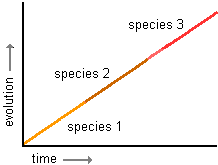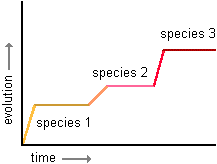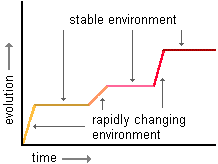 |
|
| Gradualism |
Throughout
most of the 20th century,
researchers developing the synthetic theory of evolution primarily focused on
microevolution
![]() ,
which is slight genetic change over a few generations in a population. Until
the 1970's, it was generally thought that these changes from generation to generation indicated that past
species evolved gradually into other species over millions of years.
This model of
long term gradual change is usually referred to as
gradualism or phyletic gradualism
,
which is slight genetic change over a few generations in a population. Until
the 1970's, it was generally thought that these changes from generation to generation indicated that past
species evolved gradually into other species over millions of years.
This model of
long term gradual change is usually referred to as
gradualism or phyletic gradualism
![]() . It is essentially the 19th century
Darwinian idea that species evolve slowly at a more or less steady rate. A natural
consequence of this sort of macroevolution
. It is essentially the 19th century
Darwinian idea that species evolve slowly at a more or less steady rate. A natural
consequence of this sort of macroevolution
![]() would be the slow progressive change of
one species into the next in a line, as shown by the graph on the right.
would be the slow progressive change of
one species into the next in a line, as shown by the graph on the right.
 |
|
| Punctuated equilibrium |
Beginning
in the early 1970's, this model
was challenged by Stephen J.
Gould, Niles Eldredge, and a few other leading paleontologists
![]() . They
asserted that there is
sufficient fossil evidence to
show that some species remained essentially the same for
millions of years and then underwent short periods of very rapid,
major change.
Gould suggested that a more
accurate model in such species lines would be punctuated equilibrium
. They
asserted that there is
sufficient fossil evidence to
show that some species remained essentially the same for
millions of years and then underwent short periods of very rapid,
major change.
Gould suggested that a more
accurate model in such species lines would be punctuated equilibrium
![]() (illustrated
by the graph on the left).
(illustrated
by the graph on the left).
 |
|
|
Long periods of stability
and |
The punctuated, or rapid change periods, were presumably the result of major environmental changes in such things as predation pressure, food supply and climate. During these times, natural selection can favor varieties that were previously at a comparative disadvantage. The result can be an accelerated rate of change in gene pool frequencies in the direction of the varieties that become the most favored by the new environmental conditions. It would be expected that long severe droughts, major volcanic eruptions, and the beginning and ending of ice ages would be likely triggers for rapid evolution. In such stressful situations, populations would be expected to initially diminish and become isolated. Genetic drift would then potentially speed up the rate of evolution. If by chance nature favored successful adaptations, the population would again increase in numbers as a radically changed species. Conversely, if it favored maladaptive variations, the population would decrease in numbers further and possibly even become extinct.
Random mutations provide variations that help a species survive. Mutations in regulator genes in particular can quickly result in radically new variations in the organization of the body and its important structures. As a consequence, changes in these genes can result in a greater likelihood that at least some individuals will have variations that will allow them to survive during times of extinction level events. In this situation, subsequent generations would be significantly changed from the generations before the period of severe natural selection. In other words, regulator genes probably play an important part in the rapid change phases of punctuated evolution.
Short-lived species with quick generation replacement times usually evolve at a faster rate than do large, long-lived species. This is because new genetic variations normally appear each generation as a consequence of mutation in sex cells. Those variations may be selected for or against depending on the environment at the time. As a consequence, quicker reproductive cycles generally result in speeded up species divergence. It is not surprising that there are far more species of insects and microscopic organisms than species of large trees and big animals such as elephants, horses, and humans.
Tropical species also generally evolve at a faster rate than do those from colder temperate climates. Subsequently, tropical forests are more diverse ecosystems than forests in colder regions. This is probably because warm environments promote shorter generation times and higher mutation rates.
A relatively new but extremely important factor in affecting rates of evolution has been people. There are now nearly 7 billion of us, and our numbers are growing rapidly. We have already severely changed most environments on our planet to suit our needs. In addition, we are the super predator around the globe, bringing many species to the brink of extinction and beyond. As a consequence, humans have dramatically altered natural selection. The surviving animal and plant species have responded to this pressure in a variety of ways. For instance, fish species that are heavily exploited by people now usually have smaller bodies as adults and begin to reproduce at an earlier age. It is also likely that because humans increasingly live in urban environments and rely on ever more technology, the evolution of our species has accelerated and changed in ways that are yet to be discovered.
It is apparent that the evolutionary history of life on this planet is extremely complicated. Different species have evolved at different rates and those rates have changed through time in response to complex patterns of interaction with other species and other environmental factors. In addition, it is clear that most species lines have already become extinct as a result of their inability to adapt to changed conditions.
Origin of Species
Where do new species come from? That is a key question that the biological sciences have been asking for more than 200 years. Charles Darwin gave us part of the answer in his explanation of natural selection. The remainder came as a result of Gregor Mendel's experiments with basic genetic inheritance and the 20th century discoveries of the other natural processes that can cause evolution. We now know that evolution can occur in two different patterns: adaptive radiation and successive speciation.
Adaptive radiation
![]() is the
progressive diversification of a
species into two or more species as groups adapt to different environments.
Natural selection is usually the principle mechanism driving adaptive
radiation. The initial step is the separation of a
species into distinct breeding populations. This usually happens as a
result of geographic or social isolation. Over time, the gene pools of
the isolated populations diverge from each other by gradually acquiring
different mutations and sometimes as a result of random genetic drift. When the populations are in dissimilar
environments, environmental stresses are often not the same. As a
result, nature selects for different traits existing within the
gene pools of the now cut off populations. Over time, the populations genetically diverge enough
so that they can no longer reproduce with each other. At this point,
they have become separate species and usually continue to diverge in
subsequent generations. In intermediate stages, the
two newly or about to be separated species may be able to interbreed and
produce children, but most of them are likely to be sterile. This is the
case with the offspring of female horses and
male donkeys--i.e., mules. Eventually,
however, species genetically diverge so much that they are unable to produce
any offspring. This is the case with sheep and cattle.
The process of adaptive radiation results in a branching evolutionary
pattern known as cladogenesis
is the
progressive diversification of a
species into two or more species as groups adapt to different environments.
Natural selection is usually the principle mechanism driving adaptive
radiation. The initial step is the separation of a
species into distinct breeding populations. This usually happens as a
result of geographic or social isolation. Over time, the gene pools of
the isolated populations diverge from each other by gradually acquiring
different mutations and sometimes as a result of random genetic drift. When the populations are in dissimilar
environments, environmental stresses are often not the same. As a
result, nature selects for different traits existing within the
gene pools of the now cut off populations. Over time, the populations genetically diverge enough
so that they can no longer reproduce with each other. At this point,
they have become separate species and usually continue to diverge in
subsequent generations. In intermediate stages, the
two newly or about to be separated species may be able to interbreed and
produce children, but most of them are likely to be sterile. This is the
case with the offspring of female horses and
male donkeys--i.e., mules. Eventually,
however, species genetically diverge so much that they are unable to produce
any offspring. This is the case with sheep and cattle.
The process of adaptive radiation results in a branching evolutionary
pattern known as cladogenesis
![]() .
.
|
Adaptive radiation |
|
|
The evolution of species
by
successive
speciation
![]() occurs within a single evolutionary
line without the branching of adaptive radiation. This
takes place when the
members of a species consist of a single breeding population for many
generations. Descendant generations experience continuous spontaneous
mutations and new directions of natural selection as the environment
changes. This results in progressive changes in the gene pool
frequencies of the population. At any one time, all members of the
population are the same species. However, as generations subsequently
replace each other, the gene pool is transformed--i.e., it evolves. Eventually,
the changes are great enough that if descendants could go back in time to mate
with their distant ancestors, the genetic differences would prevent them from
producing fertile offspring. In other words, they would be different
species. The process of successive speciation results
in a non-branching evolutionary pattern known as anagenesis
occurs within a single evolutionary
line without the branching of adaptive radiation. This
takes place when the
members of a species consist of a single breeding population for many
generations. Descendant generations experience continuous spontaneous
mutations and new directions of natural selection as the environment
changes. This results in progressive changes in the gene pool
frequencies of the population. At any one time, all members of the
population are the same species. However, as generations subsequently
replace each other, the gene pool is transformed--i.e., it evolves. Eventually,
the changes are great enough that if descendants could go back in time to mate
with their distant ancestors, the genetic differences would prevent them from
producing fertile offspring. In other words, they would be different
species. The process of successive speciation results
in a non-branching evolutionary pattern known as anagenesis
![]() .
.
| Successive speciation resulting in anagenesis |
 |
In the real world, the patterns of evolution can be very complex and changing. Both adaptive radiation and successive speciation can go on simultaneously.
Origin
of Life
It may seem strange that the question of the ultimate origin of life on earth was not discussed at the beginning of this tutorial. It was an intended omission. The focus has been on the processes by which living things change through time, not on how life first came about. These are separate issues. A consideration of ultimate origins bridges into the realm of religion for many people. Regardless of whether you believe that life began spontaneously as a result of natural processes or was due to divine intervention, it is sobering to realize that science is close to being able to create life out of non-living substances. In fact, most of the initial steps have already been taken. The video linked below shows just how close we are to creating living organisms.
Revealing the Origins of Life--excerpt from the PBS series Nova Science Now (February 16, 2011)
This link takes you to an external website. To return here, you must click the "back" button on
your browser program. (length = 10 mins, 50 secs)
